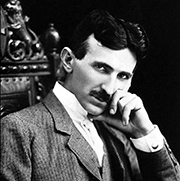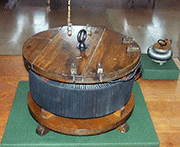E-Archive
Off the Beaten Track
in Vol. 15 - September Issue - Year 2014
The War of Currents

Thomas Edison and his antagonist George Westinghouse

Nikola Tesla

The prototype AC transformer
A world of convenience jumps into being at the flick of a switch. Lights, TV sets, computers and myriads of electric-powered devices in our homes, offices, factories, hospitals, public places and on the road; they are all there to make our lives better, safer and much more enjoyable. But how did it all get started? How did electricity, as we know it today, become the dominant power system and what happened along the way?
The Industrial Revolution and the consequent mass production of finished goods created the need for more and more power. Steam power was the most practical way to drive many types of machines and equipment, although pneumatic and hydraulic systems were also being used. Some European cities had a network of high-pressure water mains to deliver power to factory machines. The system installed in London in the nineteenth century carried water over a 290 km network of pipes at 55 bar, capable of delivering the equivalent of 5.2 MW of power. The first streetcars, or trams, were powered by telodynamics, in which the vehicles were pulled through the streets by a series of underground cables and pulleys. But all of these systems quickly showed their limits.
As the advantages of electricity became evident, different types of public and industrial applications were experimented with. One of the first applications was for public illumination. On the occasion of the Paris Exposition in 1878, an electric arc lighting system was installed along one of the city’s main avenues. Other cities in Europe and in North America quickly followed suit.
Researchers in Europe and America continued to invent new equipment and to improve on technologies for the generation, transmission and distribution of electrical power. A conflict soon arose, as competing business interests sought to dominate the market and to impose what type of distribution system would be adopted. Given the huge economic interests at stake, this conflict assumed strong and often bitter undertones and became known as "The War of Currents".
In the United States, electricity was distributed by the direct current (DC) system developed by Thomas Edison, who founded the Edison Illuminating Company to allow him to capitalize on his invention of a durable type of electric light bulb suitable for mass distribution. However, the DC system had drawbacks. The main problem was that it lacked an efficient and affordable type of transformer to convert between high and low voltage. The only type of DC transformer that was available had moving parts that had to be replaced frequently. The resultant DC distribution system had specialized generators for each required voltage level and each with its own dedicated transmission lines. For example, the electric arc public illumination system installed in New York required up to 10,000 volts, the electric motors installed on most streetcars typically needed 500 volts, whereas different factory machines required different voltage levels. Each of these different loads required setting up a different power generation system with the appropriate voltage and with its own separate distribution network. The lack of a suitable transformer also meant that power could not be transmitted great distances, as this would have had to be done at high voltage, and there was no way of stepping down the voltage for local distribution at destination. Therefore, generators had to be relatively close to their loads, especially for low voltage applications. A reliable and economical DC transformer was developed only in the 1940’s.
In the meantime, researchers in Europe were working on the alternate current (AC) system invented by Nikola Tesla. In 1884 a team of Hungarian scientists developed an efficient, economical and reliable AC transformer that contained no moving parts. This meant that voltage could be stepped up for transmission over any distance and subsequently stepped down to the required voltage for local distribution. Electric wires could be thinner and lighter compared to those used by the DC system. The Hungarians also invented a more rational power distribution system by connecting transformers in parallel to the main line, instead of connecting them in series.
When Tesla moved to the States in 1884, his work came to the attention of George Westinghouse, who was convinced of the superiority of alternating current and who was eager to offer a system in competition with Edison’s. Consequently, Westinghouse bought Tesla’s patents, and financed the establishment of an AC distribution system. The decisive moment came when Westinghouse won the bid to provide electricity to the 1893 World Colombian Exposition in Chicago, allowing him to demonstrate the efficiency, safety and reliability of the AC system and paving the way for AC distribution to become the preferred system in North America.
By Giovanni Gregorat, Contributing Editor MFN
Author: Giovanni Gregorat



























